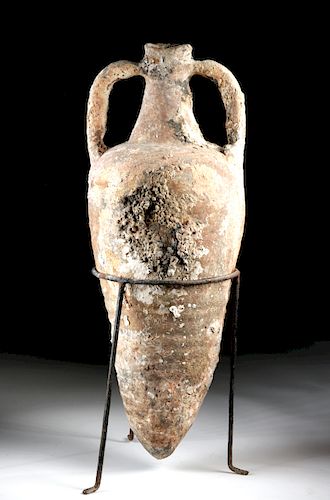Sea-Salvaged Graeco-Roman Pottery Transport Amphora
Lot 23f
About Seller
Artemis Fine Arts
686 S Taylor Ave, Ste 106
Louisville, CO 80027
United States
Selling antiquities, ancient and ethnographic art online since 1993, Artemis Gallery specializes in Classical Antiquities (Egyptian, Greek, Roman, Near Eastern), Asian, Pre-Columbian, African / Tribal / Oceanographic art. Our extensive inventory includes pottery, stone, metal, wood, glass and textil...Read more
Estimate:
$1,500 - $2,000
Absentee vs Live bid
Two ways to bid:
- Leave a max absentee bid and the platform will bid on your behalf up to your maximum bid during the live auction.
- Bid live during the auction and your bids will be submitted real-time to the auctioneer.
Bid Increments
| Price | Bid Increment |
|---|---|
| $0 | $25 |
| $300 | $50 |
| $1,000 | $100 |
| $2,000 | $250 |
| $5,000 | $500 |
| $10,000 | $1,000 |
| $20,000 | $2,500 |
| $50,000 | $5,000 |
| $100,000 | $10,000 |
| $200,000 | $20,000 |
About Auction
By Artemis Fine Arts
Jun 6, 2019
Set Reminder
2019-06-06 10:00:00
2019-06-06 10:00:00
America/New_York
Bidsquare
Bidsquare : VARIETY AUCTION | Ancient & Ethnographic
https://www.bidsquare.com/auctions/artemis-gallery/variety-auction-ancient-ethnographic-4182
Around the world & back in time - be amazed at the treasures you will find. Antiquities from Egypt, Greece, Italy and the Near East, Asian, Pre-Columbian, African / Tribal / Oceanic, Native American, Spanish Colonial, Russian Icons, Fine Art, much more! All categories, all price ranges...all legal Artemis Fine Arts info@artemisfinearts.com
Around the world & back in time - be amazed at the treasures you will find. Antiquities from Egypt, Greece, Italy and the Near East, Asian, Pre-Columbian, African / Tribal / Oceanic, Native American, Spanish Colonial, Russian Icons, Fine Art, much more! All categories, all price ranges...all legal Artemis Fine Arts info@artemisfinearts.com
- Lot Description
Roman, Graeco-Roman period, ca. 2nd century BCE to 2nd century CE. A fine buffware pottery transport amphora with a tapering piriform body, a conical base, a rounded shoulder, a cylindrical neck with a slightly-flared rim, and a pair of applied strap handles. The visible ribs on the exterior - formed during the wheel-throwing process - indicate that this was created with a utilitarian purpose in mind. Transport vessels like this example were typically not adorned with painted decorations or applied details, though some display stamped markings denoting the materials contained within. The piriform body would have held preserved meat or fruit used to sustain legions of Roman legions. Size: 7.75" W x 21" H (19.7 cm x 53.3 cm); 21.5" H (54.6 cm) on included custom stand.
Lacking its cork and pitch stopper, the original contents of this amphora are unknown; based on the conical size and shape, it was most likely used to transport stewed fruit, salted fish, or other foodstuffs (larger ones were for olive oil or wine). Amphorae formed the basis of the Roman economy as storage vessels for transporting goods throughout the Empire, with examples found from North Africa to Britain. The pointed base on this one is standard and was intended for storage in Roman warehouses in soft ground and for transport on ships by placing it through a specially-designed rack and roping it through the handles to others.
Provenance: private New York, New York, USA collection
All items legal to buy/sell under U.S. Statute covering cultural patrimony Code 2600, CHAPTER 14, and are guaranteed to be as described or your money back.
A Certificate of Authenticity will accompany all winning bids.
We ship worldwide and handle all shipping in-house for your convenience.
#146808Repaired from multiple large pieces, with small chips and light adhesive residue along break lines, and restoration to the conical base. This was recovered from the sea, hence the dense encrustations and calcifications. Chips and abrasions to base, body, handles, and rim. Nice earthen deposits, encrustations, and calcifications throughout.Condition
- Shipping Info
-
All shipping is handled in-house for your convenience. Your invoice from Artemis Gallery will include shipping calculation instructions. If in doubt, please inquire BEFORE bidding for estimated shipping costs for individual items.
-
- Buyer's Premium



 EUR
EUR CAD
CAD AUD
AUD GBP
GBP MXN
MXN HKD
HKD CNY
CNY MYR
MYR SEK
SEK SGD
SGD CHF
CHF THB
THB














